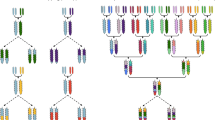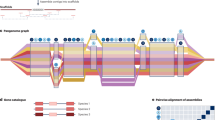Abstract
Natural variation presents one of the fundamental challenges of modern biology. Soon, the genome sequences of thousands of individuals will be known for each of several species. But how does the genotypic variation that will be observed among these individuals translate into phenotypic variation? Plants are in many ways ideal for addressing this question, and resources that are unmatched, except in humans, have now been developed.
This is a preview of subscription content, access via your institution
Access options
Subscribe to this journal
Receive 51 print issues and online access
$199.00 per year
only $3.90 per issue
Buy this article
- Purchase on Springer Link
- Instant access to full article PDF
Prices may be subject to local taxes which are calculated during checkout


Similar content being viewed by others
References
Nilsson-Ehle, H. Kreuzungsuntersuchungen an Hafer und Weizen. 1. Lunds Universitets Årsskrift 5, 1–122 (1909).
East, E. M. A Mendelian interpretation of variation that is apparently continuous. Am. Nat. 44, 65–82 (1910).
Sax, K. The association of size differences with seed coat pattern and pigmentation in Phaseolus vulgaris. Genetics 8, 552–560 (1923).
Doebley, J., Stec, A. & Hubbard, L. The evolution of apical dominance in maize. Nature 386, 485–488 (1997).
Frary, A. et al. fw2.2: a quantitative trait locus key to the evolution of tomato fruit size. Science 289, 85–88 (2000).
Fridman, E., Pleban, T. & Zamir, D. A recombination hotspot delimits a wild-species quantitative trait locus for tomato sugar content to 484 bp within an invertase gene. Proc. Natl Acad. Sci. USA 97, 4718–4723 (2000). This study pinpointed a QTL to a small intragenic region by using recombination mapping.
Yano, M. et al. Hd1, a major photoperiod sensitivity quantitative trait locus in rice, is closely related to the Arabidopsis flowering-time gene CONSTANS. Plant Cell 12, 2473–2483 (2000).
Bentsink, L., Jowett, J., Hanhart, C. J. & Koornneef, M. Cloning of DOG1, a quantitative trait locus controlling seed dormancy in Arabidopsis. Proc. Natl Acad. Sci. USA 103, 17042–17047 (2006).
Mouchel, C. F., Briggs, G. C. & Hardtke, C. S. Natural genetic variation in Arabidopsis identifies BREVIS RADIX, a novel regulator of cell proliferation and elongation in the root. Genes Dev. 18, 700–714 (2004).
Macquet, A. et al. A naturally occurring mutation in an Arabidopsis accession affects a β-d-galactosidase that increases the hydrophilic potential of rhamnogalacturonan I in seed mucilage. Plant Cell 19, 3990–4006 (2007).
Baxter, I. et al. Variation in molybdenum content across broadly distributed populations of Arabidopsis thaliana is controlled by a mitochondrial molybdenum transporter (MOT1). PLoS Genet. 4, e1000004 (2008).
The International HapMap Consortium. A haplotype map of the human genome. Nature 437, 1299–1320 (2005).
Frazer, K. A. et al. A second-generation human haplotype map of over 3.1 million SNPs. Nature 449, 851–861 (2007).
Nordborg, M. et al. The pattern of polymorphism in Arabidopsis thaliana. PLoS Biol. 3, e196 (2005).
Clark, R.M. et al. Common sequence polymorphisms shaping genetic diversity in Arabidopsis thaliana. Science 317, 338–342 (2007). This study provided the first genomic view of the pattern of polymorphism in a plant.
Kim, S. et al. Recombination and linkage disequilibrium in Arabidopsis thaliana. Nature Genet. 39, 1151–1155 (2007).
Shindo C. et al. Role of FRIGIDA and FLOWERING LOCUS C in determining variation in flowering time of Arabidopsis. Plant Physiol. 138, 1163–1173 (2005).
Thornsberry, J. M. et al. Dwarf8 polymorphisms associate with variation in flowering time. Nature Genet. 28, 286–289 (2001).
Flint-Garcia, S. A. et al. Maize association population: a high-resolution platform for quantitative trait locus dissection. Plant J. 44, 1054–1064 (2005).
Yu, J. et al. A unified mixed-model method for association mapping that accounts for multiple levels of relatedness. Nature Genet. 38, 303–308 (2006). This study identified an effective way to account for population structure in association mapping, an innovative approach that has had a large impact on the field.
Aranzana, M. J. et al. Genome-wide association mapping in Arabidopsis identifies previously known flowering time and pathogen resistance genes. PLoS Genet. 1, e60 (2005).
Zhao, K. et al. An Arabidopsis example of association mapping in structured samples. PLoS Genet. 3, e4 (2007).
Harjes, C. E. et al. Natural genetic variation in lycopene epsilon cyclase tapped for maize biofortification. Science 319, 330–333 (2008).
Balasubramanian, S. et al. The PHYTOCHROME C photoreceptor gene mediates natural variation in flowering and growth responses of Arabidopsis thaliana. Nature Genet. 38, 711–715 (2006).
Ewens, W. & Spielman, R. The transmission/disequilibrium test: history, subdivision, and admixture. Am. J. Hum. Genet. 57, 455–464 (1995).
Yu, J., Holland, J. B., McMullen, M. D. & Buckler, E. S. Genetic design and statistical power of nested association mapping in maize. Genetics 178, 539–551 (2008). This report introduced an elegant experimental combination that simultaneously exploits the advantages of mapping in experimental crosses and the increased resolution of association mapping.
Valdar, W. et al. Genome-wide genetic association of complex traits in heterogeneous stock mice. Nature Genet. 38, 879–887 (2006).
Churchill, G. A. et al. The Collaborative Cross, a community resource for the genetic analysis of complex traits. Nature Genet. 36, 1133–1137 (2004).
McCarthy, M. I. et al. Genome-wide association studies for complex traits: consensus, uncertainty and challenges. Nature Rev. Genet. 9, 356–369 (2008).
Iles, M. M. What can genome-wide association studies tell us about the genetics of common disease? PLoS Genet. 4, e33 (2008).
Ming, R. et al. The draft genome of the transgenic tropical fruit tree papaya (Carica papaya Linnaeus). Nature 452, 991–996 (2008).
Wright, S. I. The effects of artificial selection on the maize genome. Science 308, 1310–1314 (2005).
Buckler, E. S., Gaut, B. S. & McMullen, M. D. Molecular and functional diversity of maize. Curr. Opin. Plant Biol. 9, 172–176 (2006).
Korbel, J. O. et al. Paired-end mapping reveals extensive structural variation in the human genome. Science 318, 420–426 (2007).
Kidd, J. M. et al. Mapping and sequencing of structural variation from eight human genomes. Nature 453, 56–64 (2008).
Acknowledgements
Studies of natural genetic variation are supported by the National Science Foundation and the National Institutes of Health (M.N.), and by the German Research Foundation, the German Federal Ministry of Education and Research, the European Union's Sixth Framework Programme, the Human Frontier Science Program and the Max Planck Society (D.W.).
Author information
Authors and Affiliations
Ethics declarations
Competing interests
The authors declare no competing financial interests.
Additional information
Reprints and permissions information is available at http://www.nature.com/reprints.
Correspondence should be addressed to the authors (magnus@usc.edu; weigel@weigelworld.org).
Rights and permissions
About this article
Cite this article
Nordborg, M., Weigel, D. Next-generation genetics in plants. Nature 456, 720–723 (2008). https://doi.org/10.1038/nature07629
Published:
Issue Date:
DOI: https://doi.org/10.1038/nature07629
This article is cited by
-
Functional and evolutionary study of MLO gene family in the regulation of Sclerotinia stem rot resistance in Brassica napus L.
Biotechnology for Biofuels and Bioproducts (2023)
-
Genetic markers and tree properties predicting wood biorefining potential in aspen (Populus tremula) bioenergy feedstock
Biotechnology for Biofuels and Bioproducts (2023)
-
Population size in QTL detection using quantile regression in genome-wide association studies
Scientific Reports (2023)
-
Insights to Gossypium defense response against Verticillium dahliae: the Cotton Cancer
Functional & Integrative Genomics (2023)
-
Linkage and association mapping of ovule number per ovary (ON) in oilseed rape (Brassica napus L.)
Molecular Breeding (2023)
Comments
By submitting a comment you agree to abide by our Terms and Community Guidelines. If you find something abusive or that does not comply with our terms or guidelines please flag it as inappropriate.



